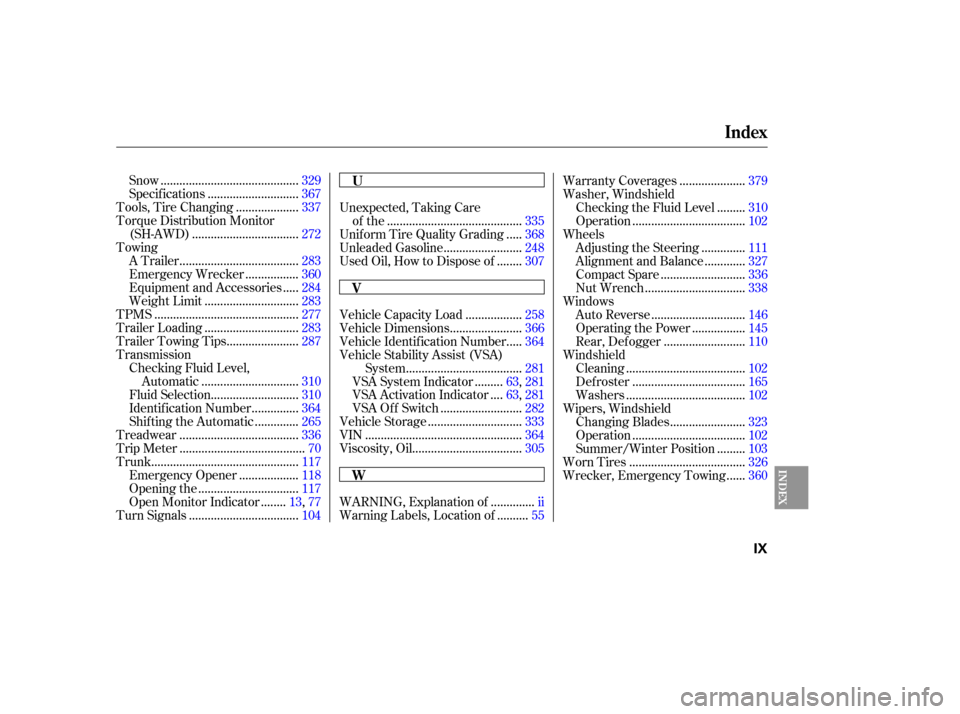TPMS Acura RL 2005 Owner's Manual
[x] Cancel search | Manufacturer: ACURA, Model Year: 2005, Model line: RL, Model: Acura RL 2005Pages: 394, PDF Size: 5.2 MB
Page 262 of 394

This section gives you tips on
starting the engine under various
conditions, and how to operate the
automatic transmission. It also
includes important inf ormation on
parking your vehicle, the braking
system, the SH-AWD system, the
vehicle stability assist (VSA) system,
the tire pressure monitoring system
(TPMS), and f acts you need if you
are planning to tow a trailer.........................
Preparing to Drive .262
.......................
Starting the Engine .263
Check Starting System ..................................
Message .264
..............
Automatic Transmission . 265
............................
SH-AWD System .272
...........................................
Parking .273
.............................
Braking System .274
................
Anti-lock Brakes(ABS) . 275
Tires Pressure ....
Monitoring System (TPMS) .277
Vehicle Stability Assist (VSA) ........................................
System .281
...........................
Towing a Trailer .283
Driving
Driving
261
Page 278 of 394

Your vehicle is equipped with a tire
pressure monitoring system (TPMS)
that turns on every time you start the
engine and monitors the pressure in
your tires while driving.
Each tire has its own pressure
sensor. If the air pressure of a tire
becomes signif icantly low, the
sensor in that tire immediately sends
a signal that causes the low tire
pressure indicator in the
instrumental panel and the
appropriate tire position indicator on
thetirepressuremonitoronthe
multi-inf ormation display (see page)tocomeon. For example, if you check and f ill
your tires in a warm area, then drive
in extremely cold weather, the tire
pressure will be lower than
measured and could be underinflated
and cause the low tire pressure
indicator to come on. Or, if you
check and adjust your tire pressure
in cooler conditions, and drive into
extremely hot conditions, the tire
maybecomeoverinflated.However,
the low tire pressure indicator will
not come on if the tires are
overinf lated.
When the low tire pressure indicator
is on, one or more of your tires is
signif icantly underinf lated. The
multi-inf ormation display also shows
a ‘‘CHECK TIRE PRESSURE’’
message (see page ). You should
stop and check your tires as soon as
possible, and inflate them to the
proper pressure as indicated on the
vehicle’s tire inf ormation placard.
Driving on a signif icantly under-
inf lated tire causes the tire to
overheat and can lead to tire failure.
Under-inf lation also reduces f uel
efficiency and tire tread life, and may
af f ect the vehicle’s handling and
stopping ability.
Becausetirepressurevariesby
temperature and other conditions,
the low tire pressure indicator may
come on unexpectedly.
Refer to page for tire inflation
guidelines.
278 279
325
CONT INUED
Low Tire Pressure
Indicator
Tire Pressure Monitoring System (TPMS)
Driving
277
Page 279 of 394

Although your tire pressure is
monitored, you must manually check
thetirepressuresmonthly.If you have a f lat tire, the low tire
pressure and tire monitor indicators
will come on. Replace the indicated
flat tire with the compact spare tire
(see page ).
When all tire pressures are normal,
the multi-information display will
show ‘‘TIRE PRESSURE OK
SYSTEM FUNCTION NORMAL.’’
Each tire, including the spare, should
be checked monthly when cold, and
set to the recommended inf lation
pressure as specif ied on the vehicle
placard and in the owner’s manual
(see page ).
If you think you can saf ely drive a
short distance to a service station,
proceed slowly to the station, then
inflate the tire to the recommended
pressure.
If the tire is f lat, or if the tire
pressure is too low to continue
driving, replace the tire with the
compact spare tire.
When any of the tires has low
pressure, the multi-inf ormation
display shows a ‘‘TIRE PRESSURE
ERROR SYSTEM FUNCTION
NORMAL’’ message (see page ).
After you replace the flat tire with
the spare, the low tire pressure
indicator stays on. This is normal;
the system is not monitoring the
spare tire pressure. Manually check
the spare tire pressure to be sure it
is correct.
Never use a puncture-repairing agent
in a f lat tire. If used, you will have to
replace the tire pressure sensor.
Havetheflattirerepairedbyyour
dealer as soon as possible.
336
326
72
Changing a T ire with T PMS T ire Pressure Monitor
Tire Pressure Monitoring System (TPMS)
278
Page 280 of 394

CONT INUED
If there is a system error with the
TPMS, the multi-inf ormation display
showsa‘‘SYSTEMFUNCTION
ERROR’’ message (see page ),
and the tire pressure readings will
not be displayed. You will also see a
‘‘CHECK TPMS SYSTEM’’ message
on the multi-information display (see
page ).If any of the tires have low pressure,
the multi-information display will
shows a ‘‘CHECK TIRE PRESSURE’’
message. You will also see one or
more low pressure tire positions
blinking in the display (see page
). When the TPMS is functioning
normally, you can press the SEL/
RESETbuttononthesteeringwheel
to see the pressure readings of each
tire in psi (U.S. models) or kPa
(Canadian models) (see page ).
280 72
277 74
Tire Pressure Monitoring System (TPMS)
T ire Pressure Readings
Driving
279
VEHICLE ICONU.S.
Page 281 of 394

If one or more tires have low
pressure, the low tire pressure
indicator on the instrument panel
also comes on (see page ).
When cruise control is on while
driving, the pressure reading cannot
be checked by the tire pressure
monitor on the multi-inf ormation
display.If there is a problem with the TPMS,
the multi-information display shows
a ‘‘CHECK TPMS SYSTEM’’
message (see page ). If you see
this message, the system is not
monitoring tire pressure. Have your
vehicle checked by a dealer as soon
as possible.If the low tire pressure indicator
comes on, or the multi-information
display shows a ‘‘CHECK TPMS
SYSTEM’’ message, the VSA system
automatically turns on even when
the VSA system is turned of f by
pressing the VSA OFF switch (see
page ). If this happens, you
cannot turn the VSA system of f by
pressing the VSA OFF switch again.
277 77282
Tire Pressure Monitoring System (TPMS)
Check T PMS System Message
280
CANADA
Page 282 of 394

When VSA activates, you may notice
that the engine does not respond to
the accelerator in the same way it
does at other times.
The VSA system cannot enhance the
vehicle’s driving stability in all
situations and does not control your
vehicle’s entire braking system. It is
still your responsibility to drive and
corner at reasonable speeds and to
leave a sufficient margin of safety.When VSA activates, you will see the
VSA activation indicator blink (see
page ).
The vehicle stability assist (VSA)
system helps to stabilize the vehicle
during cornering if the vehicle turns
more or less than desired. It also
assists you in maintaining traction
while accelerating on loose or
slippery road surf aces. It does this
by regulating the engine’s output and
by selectively applying the brakes. When the VSA system indicator
comes on, you will also see a
‘‘CHECK VSA SYSTEM’’ message
on the multi-information display.
Without VSA, your vehicle still has
normal braking and cornering ability,
but it does not have VSA traction and
stability enhancement.
If the VSA system indicator comes
on while driving, pull to the side of
theroadwhenitissafe,andturnoff
the engine. Reset the system by
restarting the engine. If the VSA
system indicator stays on, or comes
back on while driving, have the VSA
system inspected by your dealer.
If the indicator does not come on
when the ignition switch is turned to
ON (II), there may be a problem
with the VSA system. Have your
dealer inspect your vehicle as soon
as possible (see page ). If the low tire pressure indicator
comes on (see page ), or the
multi-inf ormation display shows a
‘‘CHECK TPMS SYSTEM’’ message
(see page ), the VSA system
automatically turns on even when
the VSA system is turned of f with
the VSA OFF switch. In this case,
you cannot turn the VSA system of f
by pressing the VSA OFF switch
again.
63
63 280
277
VSA A ctivation Indicator
VSA System Indicator
Vehicle Stability Assist (VSA) System
Driving
281
Page 326 of 394

CONT INUED
To saf ely operate your vehicle, your
tires must be the proper type and
size, in good condition with adequate
tread, and correctly inf lated.Keeping the tires properly inf lated
provides the best combination of
handling, tread lif e, and riding
comf ort.
Underinf lated tires wear unevenly,
adversely affect handling and fuel
economy, and are more likely to
fail from being overheated.
Overinf lated tires can make your
vehicleridemoreharshly,are
more prone to damage f rom road
hazards, and wear unevenly.
The f ollowing pages give more
detailed inf ormation on how to take
care of your tires and what to do
when they need to be replaced.
Check the pressure in the tires when
they are cold. This means the vehicle
has been parked f or at least three
hours, or driven less than 1 mile (1.6
km). Use a gauge to measure the air
pressure at least once a month. Even
tires that are in good condition may
lose one to two psi (10 to 20 kPa, 0.1
to 0.2 kgf /cm ) per month.
Remember to check the spare tire at
thesametime. We recommend that you visually
check your tires every day. If you
think a tire might be low, check it
immediately with a tire gauge.
Thetirepressuremonitoringsystem
(TPMS)willwarnyouwhenatire
pressure is low. See page f or
inf ormation on the TPMS. Add or release air, if needed, to
match the recommended cold tire
pressures on page .
277
326
Tires
Inf lation Guidelines
Maint enance
325
Using tires that are excessively
worn or improperly inflated can
cause a crash in which you can
be seriously hurt or killed.
Follow all instructions in this
owner’s manual regarding tire
inflation and maintenance.
Page 329 of 394

It is best to replace all f our tires at
thesametime.If thatisnotpossible
or necessary, replace the two f ront
tires or two rear tires as a pair.
Replacing just one tire can seriously
af f ect your vehicle’s handling.Wheels:
Tires:
See page f or DOT tire quality
grading inf ormation, and page
f or tire size explanation.
Replace your tires with radial tires of
the same size, load range, speed
rating, and maximum cold tire
pressure rating (as shown on the
tire’s sidewall).
Mixing radial and bias-ply tires on
your vehicle can reduce braking
ability, traction, and steering
accuracy. Using tires of a dif f erent
size or construction can cause the
ABS and vehicle stability assist
system (VSA) to work inconsistently. If you ever need to replace a wheel,
make sure the wheel’s specif ications
match those of the original wheel
that came on your vehicle.
Replacement wheels are available at
your Acura dealer. 368
370
Tires
Replacing T ires and Wheels Wheels and T ires
328
17x8.0JAL(TPMS)
P245/50R17 98V
Installing improper tires on your
vehicle can affect handling and
stability. This can cause a crash
in which you can be seriously
hurt or killed.
Always use the size and type of
tires recommended in this
owner’s manual.
Page 391 of 394

.
Taking Care of the Unexpected . 335
Technical Descriptions ......
DOT Tire Quality Grading . 368
.....
Emissions Control Systems . 371
Three Way Catalytic .............................
Converters .373 .......................
Temperature Gauge .68
........
Temperature, Inside Sensor . 170
....................
Temperature, Outside . 71
..............
Tether Anchorage Points . 49
Three Way Catalytic .................................
Converters .373
Tilt/Telescopic Steering .........................................
Wheel .111
....................................
Timing Belt .313
....................................
Tire Chains .329
.........
Tire, How to Change a Flat . 337
Tire Pressure Monitoring System ..................................
(TPMS) .277
Monitoring Tire Pressure ..................................
Reading .329
...........
TPMS System Warning . 280
...............................................
Tires .325
..............................
Air Pressure .326
........................................
Chains .329
.........................
Checking Wear .326
..........................
Compact Spare .336
......
DOT Tire Quality Grading . 368
......................................
Inf lation .325
..................................
Inspection .326
...................................
Replacing .328
......................................
Rotating .327
Side Marker Lights, Bulb
.........................
Replacement in .317
.............................
Signaling Turns .104
.....................................
Snow Tires .329
................................
Sound System .171
Spare Tire ......................................
Inf lating .336
............................
Specif ications .367
....................
Specif ications Charts . 366
................................
Speed Limiter .270
.......................................
Spotlights .160
..........
SRS, Additional Inf ormation . 24
...
Additional Safety Precautions . 35
..
How the SRS Indicator Works . 32
How Your Airbags ............................
Work .27, 30,32
........................
SRS Components .24
..................................
SRS Service .34
.............................
SRS Indicator .32 ,61
START (Ignition Switch .....................................
Position) .115
.......................
Starting the Engine .263
...................
Auto Control Mode . 263
In Cold Weather at High ..................................
Altitude .263
................
With a Dead Battery . 343 ..............
State Emissions Testing . 374
........
Steam Coming f rom Engine . 345
Steering Wheel ..............................
Adjustments .111
...........
Anti-thef t Column Lock . 115
......................
Position Memory .124
Steering Wheel Buttons/ .....................................
Switches .198
...................
Stereo Sound System . 171
....................
Storing Your Vehicle .333
......................................
Sun Visors .156
Supplemental Restraint ................................
System .11, 24
......................................
Servicing .34
.........................
SRS Indicator .32 ,61
...................
System Components . 24
..................................
Synthetic Oil .305
Index
T
VIII
Page 392 of 394

...........................................
Snow .329
............................
Specif ications .367
...................
Tools, Tire Changing . 337
Torque Distribution Monitor .................................
(SH-AWD) .272
Towing .....................................
A Trailer .283
................
Emergency Wrecker . 360
....
Equipment and Accessories . 284
.............................
Weight Limit .283
.............................................
TPMS .277
.............................
Trailer Loading .283
......................
Trailer Towing Tips .287
Transmission Checking Fluid Level, ..............................
Automatic .310
...........................
Fluid Selection .310
..............
Identif ication Number . 364
.............
Shif ting the Automatic . 265
.....................................
Treadwear .336
.......................................
Trip Meter .70
..............................................
Trunk .117
..................
Emergency Opener . 118
...............................
Opening the .117
.......
Open Monitor Indicator . 13,77
..................................
Turn Signals .104 Unexpected, Taking Care
..........................................
of the .335
....
Unif orm Tire Quality Grading . 368
........................
Unleaded Gasoline .248
.......
Used Oil, How to Dispose of . 307
.................
Vehicle Capacity Load . 258
......................
Vehicle Dimensions .366
....
Vehicle Identif ication Number . 364
Vehicle Stability Assist (VSA) ....................................
System .281
........
VSA System Indicator . 63,281
...
VSA Activation Indicator . 63,281
.........................
VSA Of f Switch .282
.............................
Vehicle Storage .333
.................................................
VIN .364
..................................
Viscosity, Oil .305
.............
WARNING, Explanation of . ii
.........
Warning Labels, Location of . 55....................
Warranty Coverages .379
Washer, Windshield ........
Checking the Fluid Level . 310
...................................
Operation .102
Wheels .............
Adjusting the Steering . 111
............
Alignment and Balance . 327
..........................
Compact Spare .336
...............................
Nut Wrench .338
Windows .............................
Auto Reverse .146
................
Operating the Power . 145
.........................
Rear, Def ogger .110
Windshield .....................................
Cleaning .102
...................................
Def roster .165
.....................................
Washers .102
Wipers, Windshield .......................
Changing Blades .323
...................................
Operation .102
........
Summer/Winter Position . 103
....................................
Worn Tires .326
.....
Wrecker, Emergency Towing . 360
Index
W V UINDEX
IX